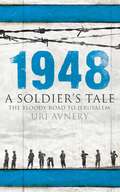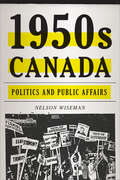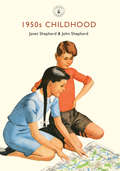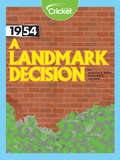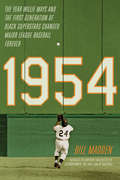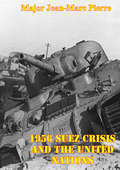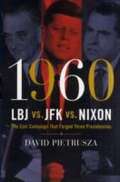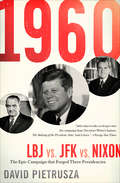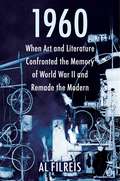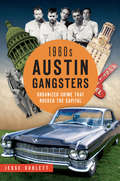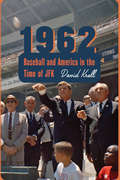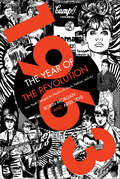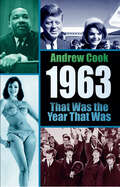- Table View
- List View
1948. A Soldier's Tale The Bloody Road to Jerusalem: A Soldier's Tale - The Bloody Road to Jerusalem
by Uri AvneryThe first eye-witness account ever published of the 1948 Israeli War of Independence, this riveting memoir of a young Israeli soldier became an instant bestseller on publication in 1949, and is still recognized as the outstanding book of that war, in the tradition of Erich Maria Remarque's All Quiet on the Western Front. First joining the Givati Brigade and later volunteering for "Samson's Foxes", the legendary commando unit, Avnery took part in almost all the major battles on the Jerusalem and southern fronts. Written from the trenches, and from a military hospital bed, he offers an extraordinarily detailed account of the war, of fast-paced battles, and acts of extreme bravery, as well as the camaraderie and off-duty exploits of young men and women thrust into the front line. This is a gripping, sensitive, and at times deeply poignant account of the day-to-day brutalities of one of the most significant wars of our times.
1948: A History Of The First Arab-israeli War
by Benny MorrisThis history of the foundational war in the Arab-Israeli conflict is groundbreaking, objective, and deeply revisionist. A riveting account of the military engagements, it also focuses on the war's political dimensions. Benny Morris probes the motives and aims of the protagonists on the basis of newly opened Israeli and Western documentation. The Arab side-where the archives are still closed-is illuminated with the help of intelligence and diplomatic materials. Morris stresses the jihadi character of the two-stage Arab assault on the Jewish community in Palestine. Throughout, he examines the dialectic between the war's military and political developments and highlights the military impetus in the creation of the refugee problem, which was a by-product of the disintegration of Palestinian Arab society. The book thoroughly investigates the role of the Great Powers-Britain, the United States, and the Soviet Union-in shaping the conflict and its tentative termination in 1949. Morris looks both at high politics and general staff decision-making processes and at the nitty-gritty of combat in the successive battles that resulted in the emergence of the State of Israel and the humiliation of the Arab world, a humiliation that underlies the continued Arab antagonism toward Israel.
1948: Harry Truman's Improbable Victory and the Year that Transformed America
by David PietruszaThe behind-the-headline true story of Harry Truman's stunning upset! Everyone knows the iconic news photo of jubilant underdog Harry Truman brandishing a copy of the Chicago Tribune proclaiming "DEWEY DEFEATS TRUMAN. " David Pietrusza goes backstage to explain how it happened, placing the brutal political battle in the context of an erupting Cold War and America's exploding storms over civil rights and domestic communism. Pietrusza achieves for 1948's presidential race what he previously did in his acclaimed 1960--LBJ vs. JFK vs. Nixon: bringing history to life and intrigue readers with tales of high drama while simultaneously presenting the issues, personalities, and controversies of this pivotal era with laser-like clarity.
1948: Harry Truman's Improbable Victory and the Year that Transformed America
by David PietruszaThe wild, combative inside story of the most stunning upset in the history of presidential elections—Harry Truman's victory over Tom Dewey: &“Outstanding.&”—Minneapolis Star-Tribune In this lively account, award-winning historian David Pietrusza unpacks the most ingloriously iconic headline in the history of presidential elections—DEWEY DEFEATS TRUMAN—to reveal the 1948 campaign's backstage events and recount the down-to-the-wire brawl fought against the background of an erupting Cold War, the Berlin Airlift, the birth of Israel, and a post-war America facing exploding storms over civil rights and domestic communism. &“Coherent, compelling…A skillful, authoritative investigation.&”—Kirkus Reviews &“A terrific book…a must-read.&”—Ron Faucheux, former editor-in-chief, Campaigns & Elections magazine &“Brilliantly portrays President Harry Truman's successful efforts to stave off the challenge of New York Gov. Tom Dewey, who was making a repeat bid as the Republican nominee.&”—David Mark, author of Going Dirty: The Art of Negative Campaigning &“Sweeping…compelling.&”—Library Journal &“Gripping detail.&”—The New York Journal of Books
1949 the First Israelis: The First Israelis
by Tom SegevRenowned historian Tom Segev strips away national myths to present a critical and clear-eyed chronicle of the year immediately following Israel’s foundation.“Required reading for all who want to understand the Arab-Israeli conflict…the best analysis…of the problems of trying to integrate so many people from such diverse cultures into one political body” (The New York Times Book Review). Historian and journalist Tom Segev stirred up controversy in Israel upon the first publication of 1949. It was a landmark book that told a different story of the country’s early years, one that wasn’t taught in schools or shown in popular culture. Rather than painting the idealized picture of the Israel’s founding in 1948, after the wreckage of the Holocaust, Segev reveals gritty underside behind the early years. The new country of Israel faced challenges on all sides. Day-to-day life was severe, marked by austerity and food shortages; Israeli society was fractured between traditional and secular camps; Jewish immigrants from Middle-Eastern countries faced discrimination and second-class treatment; and clashes between settlers and the Arabs would set the tone for relations for the following decades, hardening attitudes and creating a violent cycle of retaliation. Drawing on journal entries, letters, declassified government documents, and more, 1949 is a richly detailed look at the friction between the idealism of the Zionist movement and the cold realities of history. Decades after its publication in the United States, Segev’s groundbreaking book is still required reading for anyone who wants to understand Israel’s past and future.
1950s American Fashion
by Jonathan WalfordThe 1950s was the first decade when American fashion became truly American. The United States had always relied on Europe for its style leads, but during World War II, when necessity became the mother of invention, the country had to find its own way. American designers looked to what American women needed and found new inspirations for American fashion design. Sportswear became a strength, but not at the expense of elegance. Easy wear materials were borrowed for producing more formal clothes, and versatile separates and adaptable dress and jacket suits became hallmarks of American style. This book follows the American fashion industry, from New York's 7th Avenue to the beaches of California in search of the clothes that designed 1950s American fashion.
1950s Canada: Politics and Public Affairs
by Nelson WisemanWhile the 1950s in Canada were years of social conformity, it was also a time of political, economic, and technological change. Against a background of growing prosperity, federal and provincial politics became increasingly competitive, intergovernmental relations became more contentious, and Canada’s presence in the world expanded. The life expectancy of Canadians increased as the social pathologies of poverty, crime, and racial, ethnic, and gender discrimination were in retreat. 1950s Canada illuminates the fault lines around which Canadian politics and public affairs have revolved. Chronicling the themes and events of Canadian politics and public affairs during the 1950s, Nelson Wiseman reviews social, economic, and cultural developments during each year of the decade, focusing on developments in federal politics, intergovernmental relations, provincial affairs, and Canada’s role in the world. The book examines Canada’s subordinate relationship first with Britain and then the United States, the interplay between Quebec’s distinct society and the rest of Canada, and the regional tensions between the inner Canada of Ontario and Quebec and the outer Canada of the Atlantic and western provinces. Through this record of major events in the politics of the decade, 1950s Canada sheds light on the rapid altering of the fabric of Canadian life.
1950s Childhood
by Janet ShepherdThe generation who grew up in Britain immediately after the Second World War are popularly called 'The Baby Boomers'. As children, they experienced life in Britain from wartime austerity to the relative affluence of the late 1950s. Uniquely healthier and wealthier than previous generations, this first welfare state generation received free orange juice, milk and cod liver oil to safeguard their health. However, their overall diet was restricted until rationing fully ended in 1954 - and the permissive society had yet to arrive. Janet and John Shepherd explore how the Baby Boomers grew up through the change from post-war restrictions to a new consumer society, enjoying increased choice in the shops, while at home, pirate Radio Luxembourg and flickering black and white television opened up new vistas.
1954: A Landmark Decision
by Jacqueline B. WalkerIn the 1950s, African Americans leaders used the nation's laws and courts to confirm black citizens' rights. This article explores how America's schools finally became desegregated.
1954: The Year Willie Mays and the First Generation of Black Superstars Changed Major League Baseball Forever
by Bill Madden1954: Perhaps no single baseball season has so profoundly changed the game forever. In that year#151;the same in which the US Supreme Court unanimously ruled, in the case of Brown vs. Board of Education, that segregation of the races be outlawed in America's public schools#151;Larry Doby's Indians won an American League record 111 games, dethroned the five-straight World Series champion Yankees, and went on to play Willie Mays's Giants in the first World Series that featured players of color on both teams. Seven years after Jackie Robinson had broken the baseball color line, 1954 was a triumphant watershed season for black players#151;and, in a larger sense, for baseball and the country as a whole. While Doby was the dominant player in the American League, Mays emerged as the preeminent player in the National League, with a flair and boyish innocence that all fans, black and white, quickly came to embrace. Mays was almost instantly beloved in 1954, much of that due to how seemingly easy it was for him to live up to the effusive buildup from his Giants manager, Leo Durocher, a man more widely known for his ferocious "nice guys finish last" attitude. Award-winning, New York Times bestselling author Bill Madden delivers the first major book to fully examine the 1954 baseball season, drawn largely from exclusive recent interviews with the major players themselves, including Mays and Doby as well as New York baseball legends from that era: Yogi Berra and Whitey Ford of the Yankees, Monte Irvin of the Giants, and Carl Erskine of the Dodgers. 1954 transports readers across the baseball landscape of the time#151;from the spring training camps in Florida and Arizona to baseball cities including New York, Baltimore, Chicago, and Cleveland#151;as future superstars such as Hank Aaron, Ernie Banks, and others entered the leagues and continued to integrate the sport. Weaving together the narrative of one of baseball's greatest seasons with the racially charged events of that year, 1954 demonstrates how our national pastime#151;with the notable exception of the Yankees, who represented "white supremacy" in the game#151;was actually ahead of the curve in terms of the acceptance of black Americans, while the nation at large continued to struggle with tolerance.
1956 Suez Crisis And The United Nations
by Major Jean-Marc PierreThe 1956 Suez Crisis is the first example of a pre-emptive strike after World War II. The episode provides lessons about the lengths to which nations will go to secure their interests and the limits of the United Nation's influence. How the UN uses its power is the point of contention. In 1956, Great Britain, France, and Israel believed the organization would protect their security interests through the unbiased maintenance of international law. Yet, as common in the Cold War, UN action was hampered. A war began and ended with a cease-fire in fifty-five hours. Three militarily superior armies won their tactical fights but were strategically defeated. Most notably, the influence of global authority shifted to the superpowers. Through all this, the UN changed its mission and purpose. The primary question therefore is did the UN resolve the 1956 Suez Crisis? Resolution had to include a status quo ante bellum, the return to the existing system before the war, or the recognition of a new international Regime. The UN's ability to resolve such crises directly affects its legitimacy in the international community.
1956: The World in Revolt
by Simon HallVibrantly and perceptively told, this is the story of one remarkable year--a vivid history of exhilarating triumphs and shattering defeats around the world. 1956 was one of the most remarkable years of the twentieth century. All across the globe, ordinary people spoke out, filled the streets and city squares, and took up arms in an attempt to win their freedom. In this dramatic, page-turning history, Simon Hall takes the long view of the year's events--putting them in their post-war context and looking toward their influence on the counterculture movements of the 1960s--to tell the story of the year's epic, global struggles from the point of view of the freedom fighters, dissidents, and countless ordinary people who worked to overturn oppressive and authoritarian systems in order to build a brave new world. It was an epic contest. 1956 is the first narrative history of the year as a whole--and the first to frame its tumultuous events as part of an interconnected, global story of revolution.
1957 Fargo Tornado (Images of America)
by John Hallberg Trista Raezer-Stursa Lisa Eggebraaten Jylisa DoneyOn the evening of June 20, 1957, a tornado ripped through Fargo, North Dakota. It caused the deaths of seven children and five adults and left 116 injured. The tornado destroyed 359 buildings and damaged 2,543 more. The nine-mile path of destruction covered over 66 blocks in town, leaving more than 2,000 people homeless and causing approximately $20 million worth of damage. Following the tornado, first responders quickly united to aid those in need, setting up disaster headquarters, finding shelter for over 600 people, and distributing more than 100 tons of clothing and bedding. Dr. Tetsuya Fujita, a meteorologist, studied the Fargo tornado when creating the Fujita scale (F-scale) and later rated it an F5, the most destructive rating. Images of America: 1957 Fargo Tornado, shines a light on the tornado's destruction and the rebuilding of a united and vibrant community.
1959: The Year Everything Changed
by Fred KaplanWhile conventional accounts focus on the sixties as the era of pivotal change that swept the nation, Fred Kaplan argues that it was 1959 that ushered in the wave of tremendous cultural, political, and scientific shifts that would play out in the decades that followed. Pop culture exploded in upheaval with the rise of artists like Jasper Johns, Norman Mailer, Allen Ginsberg, and Miles Davis. Court rulings unshackled previously banned books. Political power broadened with the onset of Civil Rights laws and protests. The sexual and feminist revolutions took their first steps with the birth control pill. America entered the war in Vietnam, and a new style in superpower diplomacy took hold. The invention of the microchip and the Space Race put a new twist on the frontier myth. <P><P> <ul> <li>Vividly chronicles 1959 as a vital, overlooked year that set the world as we know it in motion, spearheading immense political, scientific, and cultural change</li> <li>Strong critical acclaim: ""Energetic and engaging"" (Washington Post); ""Immensely enjoyable . . . a first-rate book"" (New Yorker); ""Lively and filled with often funny anecdotes"" (Publishers Weekly)</li> <li>Draws fascinating parallels between the country in 1959 and today</li> </ul> <P><P>Drawing fascinating parallels between the country in 1959 and today, Kaplan offers a smart, cogent, and deeply researched take on a vital, overlooked period in American history.
1960 Winter Olympics, The (Images of Sports)
by David C. AntonucciThe 1960 Olympic Winter Games were a long-shot effort that succeeded beyond the wildest expectations. Working in a sparsely populated valley in the Sierra Nevada with only rudimentary facilities, organizers created a world-class Olympic site in four short years. For the only time in Olympic history, the venues and athlete residence halls were located in a compact, intimate setting that encouraged sportsmanship and interaction between athletes. There was elaborate pageantry in the ceremonies and decorations. The underdog American ice hockey team won the first-ever USA gold medal in that sport. American figure skaters swept gold in the individual events. Well-trained Soviet and Scandinavian athletes dominated the speed skating and cross-country skiing events. American women proved their mettle in the Alpine skiing events. German skiers made surprise upsets in the Nordic combined and ski jumping contests. And CBS-TV was there to capture the most exciting moments and make groundbreaking live broadcasts to American audiences.
1960--LBJ vs. JFK vs. Nixon: The Epic Campaign That Forged Three Presidencies
by David PietruszaIt was the election that would ultimately give America "Camelot" and its tragic aftermath, a momentous contest when three giants who each would have a chance to shape the nation battled to win the presidency. Award-winning author David Pietrusza does here for the 1960 presidential race what he did in his previous book, 1920: the Year of the Six Presidents--which Kirkus Reviews selected as one of their Best Books of 2007. Until now, the most authoritative study of the 1960 election was Theodore White's Pulitzer Prize-winning The Making of the President, 1960. But White, as a trusted insider, didn't tell all. Here's the rest of the story, what White could never have known, nor revealed. Finally, it's all out--including JFK's poignant comment on why LBJ's nomination as vice president would be inconsequential: "I'm 43 years old. I'm not going to die in office. " Combining an engaging narrative with exhaustive research, Pietrusza chronicles the pivotal election of 1960, in which issues of civil rights and religion (Kennedy was only the second major-party Roman Catholic candidate ever) converged. The volatile primary clash between Senate Majority leader LBJ and the young JFK culminated in an improbable fusion ticket. The historic, legendary Kennedy-Nixon debates followed in its wake. The first presidential televised debates, they forever altered American politics when an exhausted Nixon was unkempt and tentative in their first showdown. With 80 million viewers passing judgment, Nixon's poll numbers dropped as the charismatic Kennedy's star rose. Nixon learned his lesson--resting before subsequent debates, reluctantly wearing makeup, and challenging JFK with a more aggressive stance--but the damage was done. There's no one better to convey the drama of that tumultuous year than Pietrusza. He has 1,000 secrets to spill; a fascinating cast of characters to introduce (including a rogue's gallery of hangers-on and manipulators); and towering historical events to chronicle. And all of it is built on painstaking research and solid historical scholarship. Pietrusza tracks down every lead to create a winning, engaging, and very readable account. With the 2008 elections approaching, politics will be on everyone's mind, and 1960: LBJ vs. JFK vs. Nixon will transform the way readers see modern American history. A sampling of what Theodore White couldn't chronicle--and David Pietrusza does: · Richard Nixon's tempestuous Iowa backseat blowup, and his bizarre Election Day road trip · The full story of a sympathetic call from JFK to Coretta Scott King · John Ehrlichman's spy missions on the Nelson Rockefeller and Democratic camps · The warnings before Election Day that Chicago's mayor Daley would try to fix the race's outcome · JFK's amphetamine-fueled debate performance
1960: The Epic Campaign that Forged Three Presidencies
by David Pietrusza&“1960 aims to take us deeper into the campaign than Theodore White&’s famous The Making of the President, 1960. And it does.&”—Chicago Sun-Times This is award-winning historian David Pietrusza's hard-edged account of the 1960 presidential campaign, the election that ultimately gave America &“Camelot&” and its tragic aftermath. It is the story of the bare-knuckle politics of the primaries; the party conventions' backroom dealings; the unprecedented television debates; the hot-button issues of race, religion, and foreign policy—and, at the center of it all, three future presidents: Lyndon Johnson, John F. Kennedy, and Richard Nixon. &“Terrific.&” —Robert A. Caro, winner of two Pulitzer Prizes and the National Book Award &“A stirring, hard-edged political saga… An outstanding reexamination.&”—Booklist "1960 provides new insights into that year's hard-fought, pivotal election, but, more than that, 1960 is great storytelling—a fascinating, can&’t-put-it-down account of how American politics really works.&”—former United States Attorney General Richard Thornburgh &“Essential for understanding the political forces that in many ways shaped the world we live in today.&” —David Mark, author of Going Dirty: The Art of Negative Campaigning
1960: When Art and Literature Confronted the Memory of World War II and Remade the Modern
by Al FilreisIn 1960, when World War II might seem to have been receding into history, a number of artists and writers instead turned back to it. They chose to confront the unprecedented horror and mass killing of the war, searching for new creative and political possibilities after the conservatism of the 1950s in the long shadow of genocide.Al Filreis recasts 1960 as a turning point to offer a groundbreaking account of postwar culture. He examines an eclectic group of artistic, literary, and intellectual figures who strove to create a new language to reckon with the trauma of World War II and to imagine a new world. Filreis reflects on the belatedness of this response to the war and the Holocaust and shows how key works linked the legacies of fascism and antisemitism with American racism. In grappling with the memory of the war, he demonstrates, artists reclaimed the radical elements of modernism and brought forth original ideas about testimony to traumatic history.1960 interweaves the lives and works of figures across high and popular culture—including Chinua Achebe, Hannah Arendt, James Baldwin, Amiri Baraka, Paul Celan, John Coltrane, Frantz Fanon, Roberto Rossellini, Muriel Rukeyser, Rod Serling, and Louis Zukofsky—and considers art forms spanning poetry, fiction, memoir, film, painting, sculpture, teleplays, musical theater, and jazz. A deeply interdisciplinary cultural, literary, and intellectual history, this book also offers fresh perspective on the beginning of the 1960s.
1960Now: Photographs of Civil Rights Activists and Black Lives Matter Protests
by Sheila Pree BrightA “powerful photo collection” documenting the Black Lives Matter movement and its parallels to the historic fight for civil rights (Publishers Weekly).The fight for equality continues, from 1960 to now. Combining portraits of past and present social justice activists with documentary images from recent protests throughout the United States, #1960Now sheds light on the parallels between the 1960s Civil Rights Movement and the Black Lives Matter movement of today. Shelia Pree Bright’s striking black-and-white photographs capture the courage and conviction of ‘60s leaders and a new generation of activists, offering a powerful reminder that the fight for justice is far from over. #1960Now represents an important new contribution to American protest photography.“Visually arresting . . . activism photography shot across the U.S., from Ferguson, Missouri, to Atlanta to Philadelphia.” —Essence“While millions of cellphone photos are generated each day—some forceful testaments to racial violence and injustice—few possess the grace and quiet lyricism of her images.” —The New York Times Lens blog
1960s Austin Gangsters: Organized Crime that Rocked the Capital (True Crime)
by Jesse SublettTimmy Overton of Austin and Jerry Ray James of Odessa were football stars who traded athletics for lives of crime. The original rebels without causes, nihilists with Cadillacs and Elvis hair, the Overton gang and their associates formed a ragtag white trash mafia that bedazzled Austin law enforcement for most of the 1960s. Tied into a loose network of crooked lawyers, pimps and used car dealers who became known as the "traveling criminals," they burglarized banks and ran smuggling and prostitution rings all over Texas. Author Jesse Sublett presents a detailed account of these Austin miscreants, who rose to folk hero status despite their violent criminal acts.
1962: Baseball and America in the Time of JFK
by David KrellIn the watershed year of 1962, events and people came together to reshape baseball like never before. The season saw five no-hitters, a rare National League playoff between the Giants and the Dodgers, and a thrilling seven-game World Series where the Yankees, led by Mickey Mantle, won their twentieth title, beating the San Francisco Giants, led by Willie Mays, in their first appearance since leaving New York. Baseball was expanding with the Houston Colt .45s and the New York Mets, who tried to fill the National League void in New York but finished with 120 losses and the worst winning percentage since 1900. Despite their record, the &’62 Mets revived National League baseball in a city thirsty for an alternative to the Yankees. As the team struggled through a disastrous first year, manager Casey Stengel famously asked, &“Can&’t anybody here play this game?&” Earlier that year in Los Angeles, Dodgers owner Walter O&’Malley launched Dodger Stadium, a state-of-the-art ballpark in Chavez Ravine and a new icon for the city. For the Dodgers, Sandy Koufax pitched his first of four career no-hitters, Maury Wills set a record for stolen bases in a season, and Don Drysdale won twenty-five games. Beyond baseball, 1962 was also a momentous year in American history: Mary Early became the first Black graduate of the University of Georgia, First Lady Jackie Kennedy revealed the secrets of the White House in a television special, John Glenn became the first astronaut to orbit Earth, and JFK stared down Russia during the Cuban Missile Crisis. Weaving the 1962 baseball season within the social fabric of this era, David Krell delivers a fascinating book as epochal as its subject.
1963: How Youth Changed the World with Music, Fashion, and Art
by Robin Morgan Ariel LeveBeginning in London and ricocheting across the Atlantic, 1963: The Year of the Revolution is an oral history of twelve months that changed our world—the Youth Quake movement—and laid the foundations for the generation of today.Ariel Leve and Robin Morgan's oral history is the first book to recount the kinetic story of the twelve months that witnessed a demographic power shift—the rise of the Youth Quake movement, a cultural transformation through music, fashion, politics, theater, and film. Leve and Morgan detail how, for the first time in history, youth became a commercial and cultural force with the power to command the attention of government and religion and shape society.While the Cold War began to thaw, the race into space heated up, feminism and civil rights percolated in politics, and JFK’s assassination shocked the world, the Beatles and Bob Dylan would emerge as poster boys and the prophet of a revolution that changed the world.1963: The Year of the Revolution records, documentary-style, the incredible roller-coaster ride of those twelve months, told through the recollections of some of the period’s most influential figures—from Keith Richards to Mary Quant, Vidal Sassoon to Graham Nash, Alan Parker to Peter Frampton, Eric Clapton to Gay Talese, Stevie Nicks to Norma Kamali, and many more.
1963: That Was the Year That Was
by Andrew CookA compendium of milestone stories and watershed events in popular culture, national and international politics from 1963, including: The Beatles' first No 1, the coldest winter since 1740, Martin Luther King's 'I Have a Dream' speech, the Great Train Robbery, the Profumo Affair, Ian Brady and Myra Hindley's killings, the first woman in Space, Valentina Tereshkova, James Bond becomes an international phenomenon, 70,000 protest against nuclear weapons in London, Harold Wilson's election, and the onset of 'new politics' and satire, the assassination of JFK, the BBC launch of Doctor Who.
1964, A Year in African American Performance History (ISSN)
by David KrasnerThis book examines the Civil Rights Movement from the perspective of a single year, 1964.The book analyses specific events that occurred in 1964 as benchmarks of the Civil Right Movement, making the case that 1964 was a watershed year. Each chapter considers individually politics, rhetoric, sports, dramatic literature, film, art, and music, breaking down the events and illustrating their importance to the social and political life in the United States in 1964. This study emphasizes 1964 as a nodal point in the history of the Civil Rights Movement, arguing that it was within this single year that the tide against racism and injustice turned markedly.This book will be of great interest to the scholars and students of civil rights, theatre and performance, art history, and drama literature.
